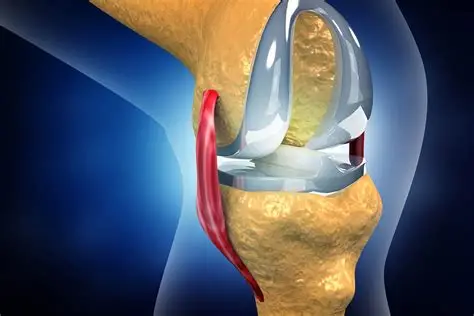The physiotherapist uses the following techniques and modalities for regaining the functionality of the knee joint.
Cryotherapy: Cryotherapy in combination with PROM exercises, elevation, and massage or compression wrapping is used to decrease edema, developed due to inactivity or loss of voluntary movements.
Thermotherapy: Thermotherapy can be used in combination with ROM exercises (twice daily) with sustained stretching technique (20 – 30minutes).
NMES: Neuromuscular stimulations facilitate voluntary motor control and muscle strength.
Ultrasound: Ultrasound is decreases pain, increases range of motion, and decreases inflammation.
Laser: Cold laser is an effective treatment used for reducing pain thus increase joint range of motion.
Phase 1: Immediate post-operative phase-days 1-10
Goals
- Active quadriceps muscle contraction
- Safe (isometric control), independent ambulation
- Passive knee extension to 0 degrees.
- Knee flexion to 90 degrees or greater.
- Control of swelling, inflammation and bleeding.
Days 1-2
- Weight–bearing with a walker as tolerated.
- Passive range of motion exercise.
- 0-40 degrees as tolerated if stable wound.
- Exercises ankle pumps with leg elevation.
- Passive knee extension exercise.
- SLR if not contraindicated.
- Quad sets.
- Knee extension exercise 90-30 degrees.
- Knee flexion exercises (gentle).
Days 4-10
- Weight-bearing, as tolerated.
- Passive range of motion, 0-90 degrees as tolerated.
Exercises
- Ankle pumps with leg elevation.
- Passive knee extension stretch.
- Active- assisted ROM knee flexion.
- Quad sets.
- SLR
- Hip abduction- adduction
- Knee extension exercise 90-0 degrees
- Gait training
- Continue safe ambulation
Phase 2: Motion Phase – weeks 2-6
Criteria for progression to phase 2.
- Leg control able to perform SLRs
- Active ROM 0-90 degrees
- Minimal pain and swelling
- Independent ambulation and transfer
Goals
- Improve ROM enhance muscular strength and endurance.
- Dynamic joint stability.
- Diminish swelling and inflammation.
- Establish a return to functional activities.
- Improve general health.
Weeks 2-4Weight-bearing with an assistive device.
Exercises
- Quad sets.
- Knee extension exercise 90-0 degrees.
- Terminal knee extension 45-0 degrees.
- SLR (flexion –extension).
- Hip abduction- adduction.
- Hamstring curls.
- Squats.
- Stretching for hamstrings, gastro- soleus, quads.
- Bed cycling ROM stimulus.
- Continue passive extension stretch.
Weeks 4-6
Exercises
- Continue all exercises listed above.
- Initiate, front and lateral step-ups, front lunge, hydrotherapy.
- Continue compression and elevation for swelling.
Phase 3: intermediate phase- Weeks 7- 12
Criteria for progression to phase 3
- ROM 0-110 degrees.
- Voluntary quadriceps muscle control.
- Independent ambulation.
- Minimal pain and inflammation.
Goals
- Progression of ROM (0-115) degrees and greater.
- Enhancement of strength and endurance.
- Eccentric concentric control of the limb
- Cardiovascular fitness
- Functional activity performance.
Weeks 7-10
Exercises
- Continue all exercises mentioned above.
- Initiate a progressive walking program
- Initiate endurance hydrotherapy exercises.
- Return to functional activities
- Lunges, squats, step-ups (small 2- inch )
- Emphasize eccentric-concentric knee control
Phase 4: Advanced Activity Phase-weeks 14-26
Criteria for Progression to phase 4
- Full, non-painful ROM (0-115 degrees).
- Strength of 4+/5 or 85% of the contra lateral limb.
- Minimal or no pain and swelling
- Satisfactory clinical examination
Goals
- Allow the patient to return to advanced level of function.
- Improve strength and endurance of the lower extremity.
- Return to a normal lifestyle.
Exercises
- Quads set
- SLR(flexion-extesnion)
- Squats
- Hip abduction-adduction
- Lateral steps up
- Knee extension exercise 90-0 degrees.
- Stretching
- Knee extension to 0 degrees
- Knee flexion to 105 degrees
- Initiate gradual walking program, sports activities


